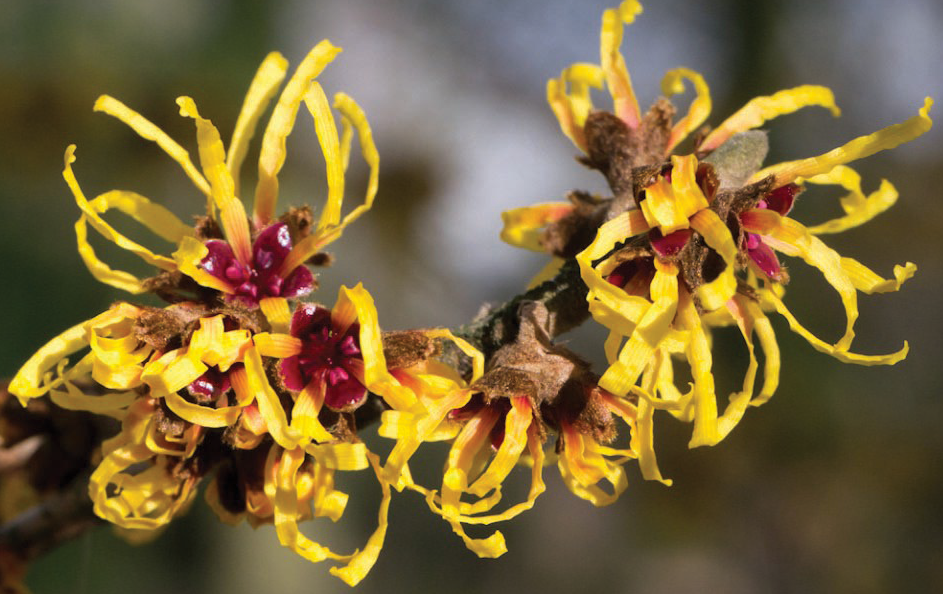Brought to you by Paul Clarke
What to do in your garden in January
Happy new year to all gardeners! Perhaps you are thinking of starting gardening for the first time – here are a few steps to beginning a garden. But first a little seasonal poem…
“In the sniffed and poured snow on the tip of the tongue of the year
That clouts the spittle like bubbles with broken rooms,
An enamoured man alone by the twigs of his eyes, two fires,
Camped in the drug-white shower of nerves and food,
Savours the lick of the times through a deadly wood of hair
In a wind that plucked a goose,
Nor ever, as the wild tongue breaks its tombs,
Rounds to look at the red, wagged root.”
Dylan Thomas, January, 1939
PAULS PLANT OF THE MONTH: Witch Hazel
Witch hazel is a large winter flowering shrub or small tree growing up to 4 metres high. It also provides attractive autumn leaf colour. In January the flowers have a delicate fragrance of warm citrus spice. Flowers tend to be predominantly yellow, but some varieties have red and orange tinges.
Witch hazel will tolerate partial shade, although they bloom better in sunny spots. Witch Hazels are a long-lived and hardy but do not like to be in a frost pocket or an exposed area. Once established, witch hazel are trouble-free. However until established for the first year you will need to water during dry periods. Pruning should take place immediately after flowering, as the flowers bloom on last year’s wood.
Pauls jobs for the month
Tools
From experience you don’t need to buy new gardening tools. You can pick up decent tools from second-hand shops and car-boot fairs . However you get what you pay for and a quality spade, fork, rake, hoe, trowel, shears and secateurs will last for years. Cheaper tools will need replacing and frustrate when they no longer do the job properly.
Assess Your Space
Consider if you are going to plant in garden beds and borders or raised beds or containers. What kind of sun does the area get? Almost all vegetables and most flowers need a good amount of full sunshine each day. Try to sketch a plan of your new garden, this will help you figure out how much of each plant you can grow and you can also consider succession planting.
Figure Out What You Want to Grow
List everything you want to grow. With the price of food rising you might want to grow vegetables. But whether you want to grow herbs, fruit or flowers have a look at some gardening books, surf the web or get 1-2 of those free garden seed catalogues and set out a little plan.
Clear the ground
On fine days in winter dig over your garden border or vegetable border. Remove all the perennial weeds.
Improve the Soil
Give your soil a boost by adding a 2- to 3-inch layer of compost, decayed leaves, dry grass clippings, or old manure into a trench. A trench can be about a spade deep and wide. All of your vegetable peelings can go into this trench.
Mulch
To help keep weeds out and water in, cover the soil with a couple of inches of mulch. For a vegetable garden use manure or peat. For perennials, use a longer-lasting mulch, such as bark chips.
Maintain Your Garden
Little and often is the best way to go to keep on top of weeds and water plants.
Enjoy the Fruits of your Labour
The exercise will have done you good and nothing tastes quite as good as home grown fruit and veg!
Also this month…
• prune wall climbers such as ivy away from window frames and gutters
• Raise pots of the ground to ensure compost drains freely
• knock snow from branches of evergreen shrubs to prevent branches breaking under the weight
• Attract birds to your garden by regularly supplying bird food and fresh water
Need some help in your garden?
One-off jobs or regular maintenance on a weekly or monthly basis contact Paul on 01284 723625 or 07952 938010
Email: burygardener@talktalk.net

